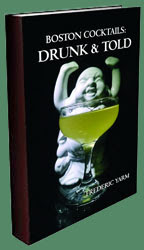1 oz Lime Juice
3/4 oz Simple Syrup
Shake with ice and strain into a cocktail glass. Garnish with 3 coffee beans. Original recipe was 3 oz of spirit which I reduced above to 2 while keeping the other volumes constant.
Two weeks ago, my friend Héctor, who I met at Eastern Standard's 75th Anniversary Prohibition Repeal Party, gave me a copy of some Peruvian cocktail recipes. Many of the recipes from Gastón Acurio en tu Cocina: Cócteles Peruanas require indigenous ingredients such as fruits and juices which are hard to acquire here in Boston; however, some like the Zambito are definitely do-able. The Zambito's lime and coffee combination stood out for it was one I had discovered worked well through a Hellfire-inspired bitters recipe I improvised last year.

(*) I used 1 tsp for every 2 oz of Pisco. Overnight infusion should be sufficient, but mine went 48 hours due to scheduling. After infusing the medium-coarsely ground coffee, I filtered it through a paper coffee filter and topped off the volume back to 2 oz with fresh Pisco (a slight loss occurs in the infusion and filtration process). A medium roast seemed to work well.

 1/2 oz Matusalem Platino Rum
1/2 oz Matusalem Platino Rum 2 oz Rittenhouse Rye
2 oz Rittenhouse Rye The theme for this month's
The theme for this month's 













 2 oz Amber Rum (Lemon Hart 80)
2 oz Amber Rum (Lemon Hart 80)




 1/4 Bourbon Whiskey (3/4 oz Eagle Rare 10 Year)
1/4 Bourbon Whiskey (3/4 oz Eagle Rare 10 Year) 1 oz Dark Spiced Rum
1 oz Dark Spiced Rum
 The 2017 collection of 855 drink recipes, bartender tributes, and essays on hospitality from CocktailVirgin's Frederic Yarm. Available at
The 2017 collection of 855 drink recipes, bartender tributes, and essays on hospitality from CocktailVirgin's Frederic Yarm. Available at  The 2012 collection of 505 drink recipes, techniques, and Boston bar recommendations from Frederic Yarm. Available at
The 2012 collection of 505 drink recipes, techniques, and Boston bar recommendations from Frederic Yarm. Available at 



